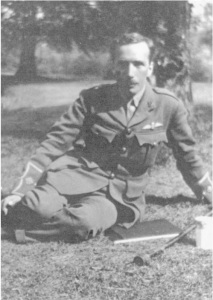The Bristol F2b went on to be one of the most successful aircraft of the war and served with the RAF until 1931. However its combat debut as the F2a was nothing short of disastrous.
In preparation for the offensive to begin on 9 April, the RFC stepped up its work today. Squadrons were out in force over the battle area to deny the Germans air superiority and carry out photography and artillery registration missions.
Hugh Trenchard had deliberately held back the deployment of the Bristol to try and surprise the Germans. In retrospect this was probably a mistake as it did not give crews to chance to gain experience in combat situations.

Edward Darien Warburton
48 Squadron, led by zeppelin hero Captain William Leefe Robinson VC had been allotted the new aircraft and flew their first combat mission today in a group of six. About 35 minutes into the mission, around 30km over the lines near Douai, Captain Robinson decided to attack a group of 6 aircraft from Jasta 11. In the ensuing combat, Captain Robinson & 2nd Lieutenant Edward Darien Warburton (in A3337) drove down one German machine out of control. Lieutenant Philip Pike and Lieutenant Hugh Bradford Griffith, also drove down a hostile machine apparently out of control. During the combat, Pike and Griffith got separated from the formation.
Unfortunately for Robinson and Warburton their engine was hit and their guns jammed, so they were forced to land. They crashed and flipped on landing and were taken prisoner. Vitzfeldwebel Sebastian Festner claimed victory. Their colleagues, Lieutenant Henry Alfred Cooper and 2nd Lieutenant Alan Boldison (in A3320) suffered the same fate. Leutnant Georg Simon claimed his first victory.

Arthur N Leckler
About 10 minutes later a second group of five aircraft, also from Jasta 11, led by Manfred Von Richthofen pounced on the remainder of the formation. Von Richthofen accounted for 2nd Lieutenant Arthur N Leckler and Lieutenant Herbert Duncan King George (In A3340). Leckler was taken prisoner but George died of his wounds the next day. Lieutenant Alfred Terence Adams and Lieutenant Donald James Stewart (in A3343) were also shot down. They crashed behind the German lines and were taken prisoner. Apparently both Bristols suffered from gun jams.
Pike and Griffith made for home and fought two rearguard actions, in one of which they claimed to have driven down one hostile aeroplane.
The story is often described as a massive triumph for Von Richthofen and Jasta 11, though as was often the case, they ended up picking on a weakened formation. The combat led Von Richthofen to underestimate the capabilities of the Bristol F2. He wrote that he found the Bristol “to be quick and rather handy…” but “The Albatros DIII was, both in speed and ability to climb, undoubtedly superior.”
What seems to have happened, partly due to a lack of combat testing is that the Bristols adopted the usual defensive circle formation and attempted to get their observers into firing position. It soon because clear that the aircraft was strong enough to be flown like a fighter and use the pilots gun as the primary weapon – with an added sting in the tail. Once this was realised, its reputation improved. Indeed, Major Arthur Vere Bettington the commander of 48 Squadron wrote a month later:
“she is a topping two-seater … faster than the Hun two-seater but cannot touch the Albatros Scout for speed. Where she does score tremendously is in her power to dive … Many Huns who have dived on the tail of one, missed and gone on diving, have been dived after and overtaken, and destroyed. … They are dived plumb vertically for thousands of feet until the noise is like that of a million sabres cleaving in the air.”